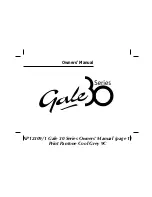
58 Live Sound International
January 2005
owed seating areas under the balcony.
The DSA concept, the brainchild of
EAW’s Dave Gunness, is fairly simple to
explain and implement, but that sim-
plicity belies a lot of sophisticated
design work. (For more about the DSA
Series, see “Designer Notebook” in the
October 2003 issue of
Live Sound.
)
The powered DSA enclosures, sim-
ilar in look and shape to classic “col-
umn loudspeakers,” incorporate elab-
orate digital signal processing (DSP)
that allows their output to be tightly
focused on the audience, and kept off
of surrounding surfaces. This cuts
reverberation, resulting in cleaner, less
cluttered and more direct sound – a
particular challenge in more reverber-
ant worship spaces.
OFFSET “LINES”
Specifically, the model DSA250 loud-
speakers used on this project include
eight 4-inch cone drivers in an offset
“line” configuration that minimizes
the height of the enclosure. The high-
frequency section is made up of eight
1-inch soft-dome tweeters integrated
with a shallow multi-cell horn
designed to keep the acoustic centers
as close as possible. Both component
configurations are designed to opti-
mize the onboard DSP control.
Zandstra was already familiar with
the DSA concept. He had implement-
ed it’s “grandfather” technology –
found in the large-format KF900 Series
loudspeakers – as the basis for a high-
output system at Spartan Stadium, an
80,000-seat open-air stadium at
Michigan State University.
“Obviously these are vastly different
projects in terms of scale and objec-
tives,” Zandstra points out. “However,
the concept, in general, is scalable, par-
ticularly in this newer DSA iteration
used at Haven. Another aspect of this
design, and one that frequency comes
up with church systems, is to minimize
the aesthetic impact of the loudspeak-
ers. The thin profile of these boxes
played into that need.”
While the previous system had uti-
lized a mono central cluster design,
the sound team wanted to try a stereo
setup that would help “open up”
musical programming, giving it added
spatial imaging. For the demo,
Zandstra brought in Genie lifts and
flew single DSA250 boxes left and
right at the front platform. Following
the sound team evaluation, he invited
church leadership to sit in for a listen.
“We were concerned about attain-
ing sufficient spoken word intelligibil-
ity with the left-right design, but the
demo proved that this could be
achieved,” Zandstra says. “The bonus
to their ears was the rather large audio
image the system put into the room.”
Once this direction was endorsed,
the Parkway install team, which also
includes electricians, got busy running
the additional cabling and AC power
“drops” needed for the new system.
Church staff also proved helpful with
handling some of these system infra-
structure issues, including setting up
additional patch panels and patch
“pockets” on stage.
Following removal of the existing
center cluster, the new loudspeakers
were flown left and right about 20 feet
above the front platform via load-rated
aircraft cable attached to certified beam
structures above the ceiling. DSA Pilot
software, loaded on a PC at the house
mix position linked to the loudspeak-
ers via RS-485, provides optimized DSP
parameters, tailored by the user.
The DSA250 loudspeakers offer a
fixed 120-degree horizontal coverage
pattern and, with the DSP, the vertical
beamwidth can be established any-
where from 15 degrees to 120 degrees.
Coverage is supplied side-to-side
across the room’s approximate 50-foot
width, with the output of the loud-
speakers divided at the center aisle.
In addition, coverage extends to
To the left, one of the underbalcony loudspeak-
ers serving shadowed regions, and above, a
rear view of one of the DSA250 mains.





















